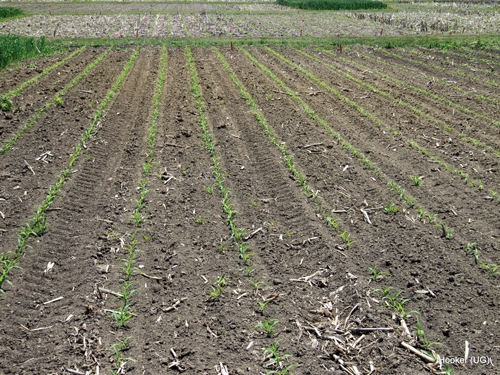
Features
Agronomy
Tillage
Twenty years of crop rotation
This year’s Farm Smart Expo saw a number of interesting speakers offering growers the results of their years of research. The University of Guelph’s Dave Hooker, assistant professor in the Department of Plant Agriculture (Ridgetown Campus), and Bill Deen, associate professor in the Department of Plant Agriculture (Guelph Campus) were on hand to talk about the economic and agronomic implications of long-term crop rotation decisions.
June 6, 2013 By Melanie Epp
 Test plots at the University of Guelph. This year’s Farm Smart Expo saw a number of interesting speakers offering growers the results of their years of research. The University of Guelph’s Dave Hooker
Test plots at the University of Guelph. This year’s Farm Smart Expo saw a number of interesting speakers offering growers the results of their years of research. The University of Guelph’s Dave HookerWhile many growers have no problems conducting their own on-farm, short-term research, it’s the long-term research that can pose a problem. That’s where researchers come in. Using five test locations, University of Guelph researchers collect long-term data that can be used to help speed up result times, eliminating the need to play sometimes-risky guessing games.
Short-term research and long-term research answers two different sets of questions. Growers can compare the success of one seed variety to another, analyze the results from a fertilized plot to a non-fertilized plot, and observe the outcome of fungicide-treated plots versus non-fungicide treated plots. All of these questions can be answered using short-term research; long-term research is reserved for some of the tougher questions.
“Basically, the answers to long-term questions tend to evolve over a long period of time,” says Hooker. “For example, organic matter changes in the soil when using different crop management systems – or crop rotation or a tillage system.”
“A grower would find long-term research extremely beneficial if they adopt a management system, and in 10 years’ time they reflect on their management system after doing an evaluation on the organic matter content of their soil,” he continues.
After that 10-year period, they’ll need to decide whether or not the system actually worked. The problem is, if it didn’t work, then they’ve essentially wasted 10 years of management. Realistically, many growers can’t spare 10 years. They need results now, he says.
“So the real benefit of these long-term trials is that we can do these trials, explore different treatments, and answer the long-term questions so growers can implement the best management practices using the long-term data that we have instead of discussing or speculating how management might affect crop productivity or sustainability in the future,” says Hooker.
Together, both researchers presented their findings at the Elora Research Station. Deen presented data from Elora, while Hooker supplemented Deen’s findings with data from Ridgetown.
Both Elora and Ridgetown have five crop rotations involving up to three crops, and two tillage systems. The five crop rotation systems include continuous corn, continuous soybeans, soybean-wheat, corn-soybean-wheat and corn-soybean. The two tillage systems include conventional and no-till.
“The Ridgetown plot has something different that the Elora plot does not have,” says Hooker. “And that is a nitrogen rate split of the plots. At Ridgetown, in the corn plots we have 0:60:120:180 kilograms per hectare of nitrogen. In the wheat plots, we have all of those rotations and tillage combinations, but we also have another split and that’s 0:50:100:150 kilograms per hectare. The wheat plots are further divided up into with and without under-seeded red clover.”
Although the two stations operate similar test plots, they are on two very different types of soil, which can affect long-term results. Ridgetown is on a Brookston clay loam, a fine-textured soil that is heavier than the silt loam found in Elora.
“If I was a grower and I had loam or silt loam, I would probably be looking at the Elora rotation more closely than the Ridgetown one,” says Hooker. “But if I had a fine-textured soil like a clay or a clay loam, I would be looking at the results from the Ridgetown trials more closely.”
The results
- The corn-soybean rotation did not produce good soil quality with high organic matter, good soil tilth and aggregate stability.
- When wheat is included in the rotation – as in, corn-soybean-wheat – corn yields increased by as much as 30 bushels per acre. Soybean yields were four to six bushels per acre more when wheat was included in the rotation.
- When you include nitrogen in the system, it increases the amount of carbon or biomass return to the soil. In that corn-soybean-wheat rotation soil quality was superior through higher organic matter, greater aggregate stability and better soil structure.
Given that there are only four to five research facilities with test plots like this, farmers will have to take the information at hand and experiment with rotations on their own farms to see how they work.
“At least this gives a first-line answer to some of the questions that they have on which rotations are better than the other or which tillage systems are better,” says Hooker.
Look for more information online at www.ontariosoilcrop.org.